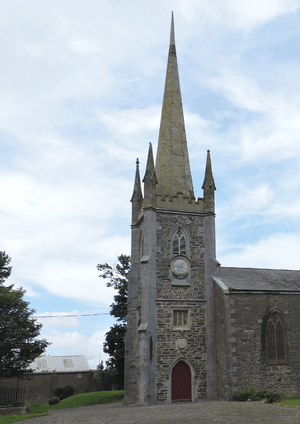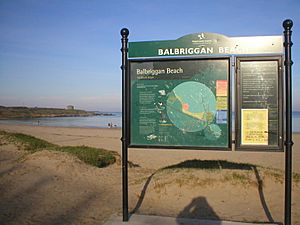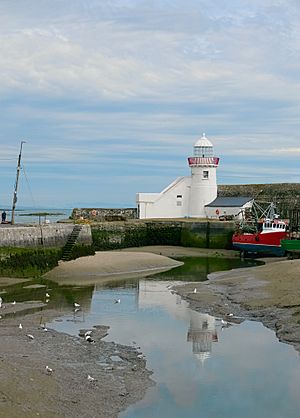Balbriggan facts for kids
Quick facts for kids
Balbriggan
Baile Brigín
|
|
|---|---|
|
Town
|
|
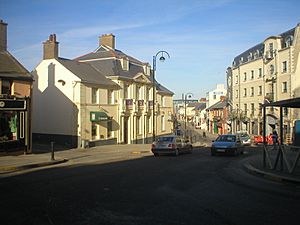
Bridge Street, Balbriggan
|
|
| Motto(s):
People before Leaders
|
|
| Country | Ireland |
| Province | Leinster |
| County | Fingal |
| Dáil Éireann | Dublin Fingal |
| EU Parliament | Dublin |
| Elevation | 6 m (20 ft) |
| Population
(2016)
|
|
| • Total | 21,722 |
| Time zone | UTC±0 (WET) |
| • Summer (DST) | UTC+1 (IST) |
| Eircode routing key |
K32
|
| Telephone area code | +353(0)1 |
| Irish Grid Reference | O200641 |
Balbriggan ( Irish: Baile Brigín) is a town located about 34 kilometers (21 miles) north of Dublin city. It's in the northern part of Fingal, Ireland. In 2016, the town and its surrounding areas had a population of 21,722 people.
Contents
- What does the name Balbriggan mean?
- A Look at Balbriggan's History
- Getting to Balbriggan
- Balbriggan's Geography
- Fun Things to Do in Balbriggan
- Balbriggan's Economy
- Interesting Buildings in Balbriggan
- Balbriggan's Population
- Schools in Balbriggan
- Sports in Balbriggan
- Religion in Balbriggan
- Famous People from Balbriggan
- See also
What does the name Balbriggan mean?
The name Balbriggan comes from the Irish language. One idea is that it means "Brecan's Town," named after a common old Irish name, Brecan. There are other places in Ireland with similar names.
Another idea is that the name is linked to the local Bracken River. If so, it could mean "little trout." Many local people also believe that Baile Brigín means "Town of the Little Hills," because of the small hills around the town.
A Look at Balbriggan's History
People aren't sure exactly when Balbriggan started. It was likely always a small settlement with fishermen, weavers, and farmers trading goods.
Balbriggan in the 1700s
In the 1700s, a traveler described Balbriggan as a "small village" with a "little harbour." It was a safe place for ships and had a good pier. People also visited in the summer to enjoy bathing in the sea.
Balbriggan grew from a small fishing village into an important place for making things and trading. This happened partly because of George Hamilton, a local landowner and judge. In 1780, he set up factories to make cotton. He also made the harbour better by building the pier, which was finished in 1763.
Balbriggan in the 1800s
In 1837, a book called Lewis's Topographical Directory of Ireland described Balbriggan. It said the town had 3,016 people. Many people worked in fishing, but most worked in cotton factories. These factories used steam engines and water wheels to power their machines. Over 300 people worked there, making cotton yarn.
The town was also famous for making fine cotton stockings. This business had been going on for about 40 years. Even famous people like Queen Victoria and the Czarina of Russia wore "Balbriggans" stockings!
The harbour was made safe for ships by a great pier, finished in 1763. Another pier was built between 1826 and 1829, making an inner harbour. This helped protect ships from strong winds. There was also a lighthouse at the end of the old pier.
Balbriggan had a market on Mondays for corn, which was sent to Dublin and Liverpool. There was also a market for food on Saturdays. Fairs for cattle were held twice a year. The town also had a market-house built in 1811.
Important Historical Events
Medieval Battle
A long time ago, in 1329, a battle happened in Balbriggan. It was between two groups of families. One group, led by John de Bermingham and Richard, Lord of Malahide, fought against local rival families. Sadly, 60 people from the first group were killed.
Textile Industry
Balbriggan was home to Smith's Stocking Mill in the 1800s. They made famous stockings and even men's underwear called "Balbriggans."
Another important company was Charles Gallen & Company. In 1870, they bought the old weaving mill built by Baron Hamilton. They became known for making the finest linen in Ireland. Their products were used all over the world, including in the Vatican and US Embassies. The business still continues today from a different location.
The Sack of Balbriggan
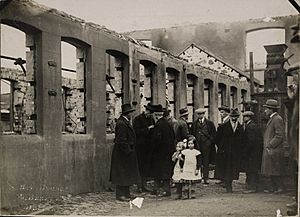
In September 1920, during the Irish War of Independence, Balbriggan experienced a difficult time. Some British forces attacked the town. This event was called the "Sack of Balbriggan." Many houses and a factory were destroyed, and some shops were looted.
Because Balbriggan was close to Dublin, where many foreign news reporters were, this event got a lot of international attention. A group from the United States even promised to help rebuild homes and a factory in the town. Other people also died during this time, including Séamus Lawless and Sean Gibbons. A special plaque on Bridge Street remembers them.
Getting to Balbriggan
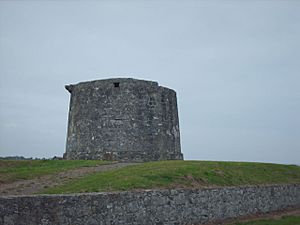
Balbriggan is about 32 kilometers (20 miles) north of Dublin city. It's on the main train line between Belfast and Dublin. Many people use the Balbriggan railway station for their daily commute. The station opened in 1844.
The town is also right next to the M1 motorway, which was finished in 1998. Before that, the main road from Dublin to Belfast went right through the town, causing a lot of traffic. Now, the motorway helps traffic flow much better.
You can also get to Balbriggan by bus. Dublin Bus and Bus Éireann offer services to and from the town.
Balbriggan is the most northern town in Fingal. It's also close to other towns like Bettystown, Laytown, and Drogheda.
In the early 2000s, Balbriggan's population grew a lot. Many new homes were built because more housing was needed in the Dublin area.
Balbriggan's Geography
The River Bracken, also known as the Matt River, flows through Balbriggan. This river once formed a lake. The water from this lake was used to power a waterwheel at a cotton factory. In the 1960s, the wall holding the water back broke. The area was later filled in to create a public park.
On the northern side of town, another small river, the Bremore River, flows into the sea near the Martello Tower.
Fun Things to Do in Balbriggan
The town is on the coast and has a sandy beach. It used to be a popular holiday spot for people from Dublin.
Balbriggan is also home to a Sunshine Home. This special place provides holidays for children aged 7 to 11 from less fortunate areas around Dublin. It's run by the Sunshine Fund, a part of the Society of Saint Vincent de Paul. The home has been hosting these holidays since 1935, helping over 100,000 young people enjoy a break.
Balbriggan's Economy
The Department of Foreign Affairs has a passport production center in Balbriggan. There's also a plan to move the Drogheda International Seaport to the Bremore Port area, just north of the town. Local groups believe that the planned Bremore Port, along with the existing M1 motorway and railway, will attract new companies to the area.
Some companies already in Balbriggan include Techrete, which makes precast concrete, and Wavin, which has been making plastic pipes since 1962.
Interesting Buildings in Balbriggan
Balbriggan has several notable buildings:
- Balbriggan Market House: This building, with five bays and two floors, dates back to 1811.
- Balbriggan Carnegie Free Library: Built around 1905.
- National Irish Bank building: Located on Drogheda Street, built around 1885.
- Balbriggan Court House: Built around 1844.
- Balbriggan Railway Viaduct: Built around 1843.
- Loreto Convent: Built around 1905.
- St. Peter and Paul's Church: Built in 1842 in the Gothic Revival style. It has beautiful stained glass windows by Harry Clarke.
- St. Georges Church: Built in 1813, also in the Gothic Revival style.
- Lighthouse: Built in 1761, it's an important historical building.
- Bremore Castle: This castle was built in the 14th century. It fell into disrepair but has been restored.
- Martello Tower: This tower was built by the British during the Napoleonic Wars. It's one of many such towers along the coast.
Balbriggan's Population
In 2011, about 31% of the people living in Balbriggan were from non-Irish backgrounds. The population of the town and its surrounding areas grew to almost 23,000 by 2015.
Schools in Balbriggan
Primary Schools
Balbriggan has many primary schools. These include Roman Catholic and Church of Ireland national schools, an Irish-language school called a gaelscoil, and several Educate Together schools. There are also primary schools in nearby Balscadden and Balrothery.
Secondary Schools
There are five secondary schools in the town:
- Ardgillan Community College (opened 2009)
- Bremore Educate Together
- Loreto Secondary
- Balbriggan Community College
- Coláiste Ghlór na Mara (an Irish-language secondary school)
Ardgillan Community College had to close temporarily in October 2018 due to fire safety concerns.
Adult Education
The Fingal Adult Education Service offers courses for adults, both full-time and part-time.
Sports in Balbriggan
Athletics
Balbriggan and District AC is the local athletics club. Kids as young as 6 can join their "Little Athletes" program. Members from age 8 compete in various events, up to adult levels. The club welcomes everyone.
Gaelic Games
O'Dwyers GAA is the local Gaelic Athletic Association club, started in 1918. They offer "skills camps" for younger players. The club plays Gaelic football and hurling for boys, girls, and mixed teams. There's also a junior camogie team. For adults, they have football and hurling teams.
Soccer
Balbriggan has several association football (soccer) clubs:
- Balbriggan Football Club: Started in 1982, this club has youth teams and three senior teams. They are building a new clubhouse.
- Glebe North Football Club: Established in 1945, this club has two senior teams and 16 schoolboy/girl teams. They have a floodlit main pitch and an all-weather pitch.
- Hyde Park Football Club and Ringcommon Wanderers Football Club also represent the area. Ringcommon Wanderers has women's and men's senior teams.
- Balrothery Football Club: This is the newest club in Balbriggan. They use the Ring Commons sports facilities, which include soccer pitches, a Pitch and Putt course, and a rugby pitch.
Rugby
Balbriggan Rugby Football Club was founded in 1925. They have men's and women's teams, as well as many youth teams for boys and girls. They also have special needs rugby teams. The club moved to new grounds outside Balrothery in 2007. They have excellent floodlighting and an all-weather pitch. In 2020, the club opened its first permanent clubhouse.
Other Sports
- Balrothery Balbriggan Tennis Club: A tennis club for Balrothery, Balbriggan, and nearby areas.
- Balbriggan Cricket Club: Their home ground is in the 'Town Park'.
- Balbriggan Golf Club: An 18-hole golf course established in 1945.
- Ringcommons Pitch & Putt club: Established in 1998, it has an 18-hole pitch and putt course.
Religion in Balbriggan
Balbriggan is a Roman Catholic parish. The main church is the Church of Ss. Peter and Paul, where Mass is held in English and Polish. This church has two beautiful stained glass windows made by Harry Clarke.
For the Church of Ireland, Balbriggan is part of a larger parish with Balrothery and Balscadden. Their church, on Church Street, is called St. George's.
There are also Baptist and Pentecostal churches in Balbriggan.
Famous People from Balbriggan
- George Hamilton (1732–1793): A politician, judge, and landowner who helped improve the town and its harbour.
- George Alexander Hamilton (1802–1871): A Member of Parliament and civil servant, and George Hamilton's grandson. He also helped the town a lot.
- Harry Reynolds (1874–1940): The first Irishman to win a world championship in cycling.
- Sinéad de Valera (1878–1975): An author and the wife of former Irish leader and President Éamon de Valera.
- Gertie Shields (1930–2015): She started "Mothers against Drink Driving" and was a member of the town council.
- Trevor Sargent (1960–present): A former leader of the Green Party and a government minister.
- Lesley Roy (1986–present): A singer/songwriter who represented Ireland in the Eurovision Song Contest in 2020 and 2021.
See also
 In Spanish: Balbriggan para niños
In Spanish: Balbriggan para niños



